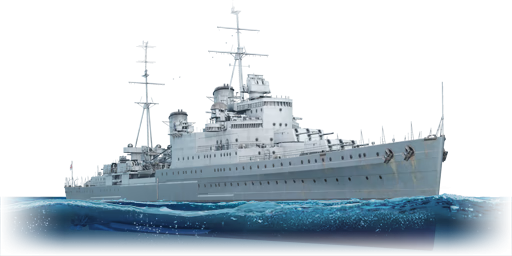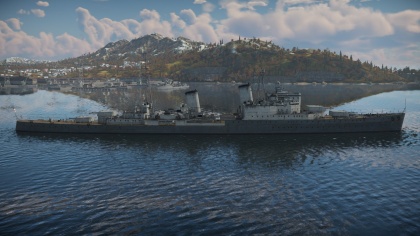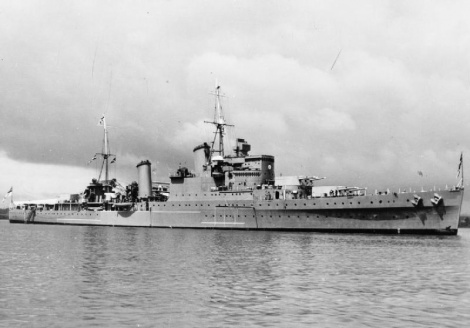Difference between revisions of "HMS Southampton"
Bonisducks (talk | contribs) (History, To Be Completed.) (Tag: Visual edit) |
Bonisducks (talk | contribs) (→History) (Tag: Visual edit) |
||
| Line 91: | Line 91: | ||
== History == | == History == | ||
<!-- Describe the history of the creation and combat usage of the ship in more detail than in the introduction. If the historical reference turns out to be too long, take it to a separate article, taking a link to the article about the vehicle and adding a block "/ History" (example: https://wiki.warthunder.com/(Vehicle-name)/History) and add a link to it here using the main template. Be sure to reference text and sources by using <ref>, as well as adding them at the end of the article. -->[[File:HMS Southampton 1937.jpg|thumb|470x470px|HMS Southampton before her refit in 1937.]] | <!-- Describe the history of the creation and combat usage of the ship in more detail than in the introduction. If the historical reference turns out to be too long, take it to a separate article, taking a link to the article about the vehicle and adding a block "/ History" (example: https://wiki.warthunder.com/(Vehicle-name)/History) and add a link to it here using the main template. Be sure to reference text and sources by using <ref>, as well as adding them at the end of the article. -->[[File:HMS Southampton 1937.jpg|thumb|470x470px|HMS Southampton before her refit in 1937.]] | ||
| − | The ''HMS Southampton'', pennant number 83, is a light cruiser of the Town class. Launched in 1936, she went on to see service during the Second World War. She initially served as the flagship of the 2nd Cruiser squadron of the Home Fleet, and later participated in several engagements with German vessels. She was reassigned to the Mediterranean in October of 1940. However, in January 1941, she was bombed by Italian aircraft and suffered crippling damage. As a result, she was scuttled with torpedoes from her escorts. | + | The ''HMS Southampton'', pennant number 83, is a light cruiser of the Town class. Launched in 1936, she went on to see service during the Second World War. She initially served as the flagship of the 2nd Cruiser squadron of the Home Fleet, and later participated in several engagements with German vessels. She was reassigned to the Mediterranean in October of 1940. However, in January 1941, she was bombed by Italian aircraft and suffered crippling damage. As a result, she was scuttled with torpedoes from her escorts.<ref name=":1">https://uboat.net/allies/warships/ship/1235.html</ref> |
=== Design and development === | === Design and development === | ||
| Line 99: | Line 99: | ||
=== Operational history === | === Operational history === | ||
| − | Following her commissioning, the ''Southampton'' entered service with the 2nd Cruiser squadron of the British Home Fleet. After the outbreak of the Second World War, she participated in the hunts for the German merchant ''Johannes Molkenbuhr'' and the battlecruisers ''Scharnhorst'' and ''Gneisenau''. During this time, she was damaged twice; first by a 500kg bomb while she was laid up at Rosyth, and later by a German air attack off the coast of Norway. | + | Following her commissioning, the ''Southampton'' entered service with the 2nd Cruiser squadron of the British Home Fleet. After the outbreak of the Second World War, she participated in the hunts for the German merchant ''Johannes Molkenbuhr'' and the battlecruisers ''Scharnhorst'' and ''Gneisenau''. During this time, she was damaged twice; first by a 500kg bomb while she was laid up at Rosyth, and later by a German air attack off the coast of Norway.<ref name=":1" /> |
| − | In November of 1940, ''Southampto''n sailed for the Mediterranean. She later participated in the Battle of Cape Spartivento and escorted resupply missions to Malta. However, on January 11th of 1941, she was attacked by twelve Stukas of the ''Luffewaffe''. Hit by two bombs, the ship caught fire and suffered severe damage. With 80 sailors dead and no electrical power, the decision was made to scuttle the ship. Thus, she was sunk by four torpedoes from the cruiser ''Orion'' and a single torpedo from her sister ship ''Gloucester''. | + | In November of 1940, ''Southampto''n sailed for the Mediterranean. She later participated in the Battle of Cape Spartivento and escorted resupply missions to Malta. However, on January 11th of 1941, she was attacked by twelve Stukas of the ''Luffewaffe''. Hit by two bombs, the ship caught fire and suffered severe damage. With 80 sailors dead and no electrical power, the decision was made to scuttle the ship. Thus, she was sunk by four torpedoes from the cruiser ''Orion'' and a single torpedo from her sister ship ''Gloucester''.<ref name=":1" /> |
== Media == | == Media == | ||
| Line 121: | Line 121: | ||
{{Britain light cruisers}} | {{Britain light cruisers}} | ||
| + | <references /> | ||
Revision as of 01:56, 18 November 2020
Contents
Description
The Town-class, HMS Southampton (C83), 1940 is a rank IV British light cruiser
with a battle rating of 5.7 (AB/RB/SB). It was introduced in Update 1.89 "Imperial Navy".
General info
Survivability and armour
Talk about the vehicle's armour. Note the most well-defended and most vulnerable zones, e.g. the ammo magazine. Evaluate the composition of components and assemblies responsible for movement and manoeuvrability. Evaluate the survivability of the primary and secondary armament separately. Don't forget to mention the size of the crew, which plays an important role in fleet mechanics. Save tips for preserving survivability in the "Use in battle" section.
If necessary, use a graphics template to show the most well-protected or most vulnerable points in the armour.
Mobility
Write about the ship’s mobility. Evaluate its power and manoeuvrability, rudder rerouting speed, stopping speed at full tilt, with its maximum forward speed and reverse speed.
Armament
Primary armament
Provide information about the characteristics of the primary armament. Evaluate their efficacy in battle based on their reload speed, ballistics and the capacity of their shells.
Broadly describe the ammunition available for the primary armament, and provide recommendations on how to use it and which ammunition to choose.
Secondary armament
Some ships are fitted with weapons of various calibres. The secondary armament is defined as the weapon chosen with the control Select secondary weapon. Evaluate the secondary armament and give advice on how to use them. Describe the ammunition available for the secondary armament. Provide recommendations on how to use them and which ammunition to choose. Remember that anti-air armament, even heavy calibre weapons, belong in the next section.
Anti-aircraft armament
An important part of the ship’s armament responsible for air raid defence. Anti-aircraft armament is defined by the weapon chosen with the control Select anti-aircraft weapons. Talk about the ship’s anti-air cannons and machine guns, the number of guns and their positions, their effective range, and about their overall effectiveness – including against surface targets.
Torpedo armament
Torpedoes launchers are standard equipment on many ships and boats. Torpedoes are a significant means of defeating an opponent. Evaluate the position of the torpedo launchers, discuss the ammunition available, firing specifics such as dead zones, features of the torpedoes themselves, etc.
Usage in battles
Describe the technique of using this ship, the characteristics of her use in a team and tips on strategy. Abstain from writing an entire guide – don’t try to provide a single point of view, but give the reader food for thought. Talk about the most dangerous opponents for this vehicle and provide recommendations on fighting them. If necessary, note the specifics of playing with this vehicle in various modes (AB, RB, SB).
Modules
| Tier | Seakeeping | Unsinkability | Firepower | |||
|---|---|---|---|---|---|---|
| I | Dry-Docking | Tool Set | 6 inch CPBC | 4 inch SAP | Anti-Air Armament Targeting | |
| II | Rudder Replacement | Fire Protection System | Smokescreen | 6 inch HE-TF | 4 inch HE-TF | Auxiliary Armament Targeting |
| III | Propeller Replacement | Shrapnel Protection | Ventilation | Improved Rangefinder | 4 inch HE-VT | Primary Armament Targeting |
| IV | Engine Maintenance | New Pumps | Ammo Wetting | 6 inch HE-VT | Torpedo Mode | |
Pros and cons
Summarize and briefly evaluate the vehicle in terms of its characteristics and combat effectiveness. Mark its pros and cons in the bulleted list. Try not to use more than 6 points for each of the characteristics. Avoid using categorical definitions such as "bad", "good" and the like - use substitutions with softer forms such as "inadequate" and "effective".
Pros:
Cons:
History
The HMS Southampton, pennant number 83, is a light cruiser of the Town class. Launched in 1936, she went on to see service during the Second World War. She initially served as the flagship of the 2nd Cruiser squadron of the Home Fleet, and later participated in several engagements with German vessels. She was reassigned to the Mediterranean in October of 1940. However, in January 1941, she was bombed by Italian aircraft and suffered crippling damage. As a result, she was scuttled with torpedoes from her escorts.[1]
Design and development
The Southampton was a member of the Town class, a group of light cruisers built in the 1930s. Initially intended to be built as Arethusa-class cruisers, the design was changed after the construction of the American Brooklyn-class and Japanese Mogami-class ships. The vessels were 180 metres long and displaced 11 000 tons, as they weren’t regulated by the Washington naval treaty.[2] The ships carried an armament of twelve 152 mm guns in four triple turrets, a big upgrade from the six-gun Arethusas. The ships also carried numerous anti-aircraft defenses, and two triple torpedo launchers. She was capable of 32 knots (59 km/h).[2]
The HMS Southampton was laid down on November 11th 1934, and launched on March 10th 1936.[2] She was formally commissioned into the Royal Navy in March of 1937.[2]
Operational history
Following her commissioning, the Southampton entered service with the 2nd Cruiser squadron of the British Home Fleet. After the outbreak of the Second World War, she participated in the hunts for the German merchant Johannes Molkenbuhr and the battlecruisers Scharnhorst and Gneisenau. During this time, she was damaged twice; first by a 500kg bomb while she was laid up at Rosyth, and later by a German air attack off the coast of Norway.[1]
In November of 1940, Southampton sailed for the Mediterranean. She later participated in the Battle of Cape Spartivento and escorted resupply missions to Malta. However, on January 11th of 1941, she was attacked by twelve Stukas of the Luffewaffe. Hit by two bombs, the ship caught fire and suffered severe damage. With 80 sailors dead and no electrical power, the decision was made to scuttle the ship. Thus, she was sunk by four torpedoes from the cruiser Orion and a single torpedo from her sister ship Gloucester.[1]
Media
See also
Links to the articles on the War Thunder Wiki that you think will be useful for the reader, for example:
- reference to the series of the ship;
- links to approximate analogues of other nations and research trees.
External links
Paste links to sources and external resources, such as:
- topic on the official game forum;
- encyclopedia page on the ship;
- other literature.
| Britain light cruisers | |
|---|---|
| Emerald-class | HMS Enterprise |
| Dido-class | HMS Dido |
| Leander-class | HMNZS Leander |
| Arethusa-class | HMS Arethusa |
| Town-class | HMS Belfast · HMS Liverpool · HMS Southampton |
| Tiger-class | HMS Tiger |
| Abdiel-class* | HMS Abdiel |






